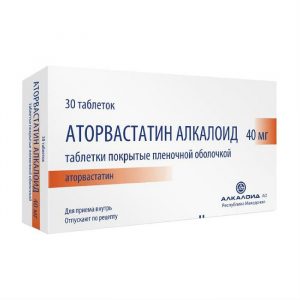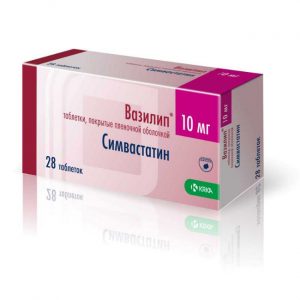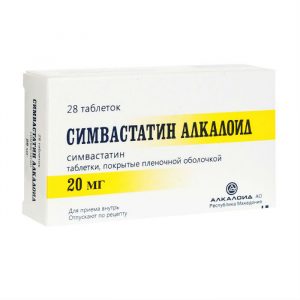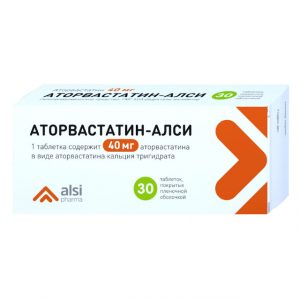Description
Description
Round biconvex tablets, film-coated from brown to light brown with a pinkish tint.
Indications
Hypercholesterolemia:
Primary hypercholesterolemia (type IIa and IIb) with the ineffectiveness of dietary therapy with low cholesterol and other non-pharmacological measures (physical activity and weight loss) in patients with an increased risk of coronary atherosclerosis
Combined hypercholesterolemia and hypertriglyceridemia, special and non-correctable diets.
Coronary heart disease:
For the prevention of myocardial infarction,
To reduce the risk of death,
Reduce the risk of cardiovascular disorders (stroke or transient ischemic attacks),
Slow the progression of coronary atherosclerosis,
Reduce the risk of revascular procedures.
Contraindications
Hypersensitivity to simvastatin or to other components of the drug (including hereditary lactose intolerance), as well as to other statin drugs (HMG-CoA reductase inhibitors) in the history of
Liver diseases in the active phase, persistent increase in liver enzyme activity of unknown etiology
Skeletal muscle disease (myopathy)
Age up to 18 years (efficacy and safety have not been established).
Prescribed with caution in patients: Alcohol-abusing
For patients after organ transplantation who are being treated with immunosuppressive drugs (due to an increased risk of rhabdomyolysis and renal failure)
In conditions that may lead to severe renal failure, such as arterial hypotension, severe acute infectious diseases, severe metabolic and endocrine disorders, water-electrolyte imbalance, surgical interventions (including dental) or
injuries Patients with reduced or increased skeletal muscle tone of unknown etiology
Epilepsy
Recommendations for the use of
Before starting treatment with simvastatin, the patient should be prescribed a standard hypocholesterol diet, which must be followed throughout the course of treatment.
Simvastatin should be taken orally once a day in the evening, drinking plenty of water.
The time of taking the drug should not be associated with a meal.
The recommended dose of simvastatin for the treatment of hypercholesterolemia varies from 10 to 80 mg once daily in the evening. The recommended starting dose for patients with hypercholesterolemia is 10 mg. The maximum daily dose is 80 mg.
Changes (selection) of the dose should be carried out at intervals of 4 weeks. In most patients, the optimal effect is achieved when taking the drug in doses up to 20 mg per day.
In patients with homozygous hereditary hypercholesterolemia, the recommended daily dose of Simvastatin is 40 mg once daily in the evening or 80 mg in three divided doses (20 mg in the morning, 20 mg in the afternoon and 40 mg in the evening).
In the treatment of patients with coronary heart disease (CHD) or a high risk of developing coronary heart disease, effective doses of simvastatin are 20-40 mg per day. Therefore, the recommended initial dose in such patients is 20 mg per day. Changes (selection) of the dose should be carried out at intervals of 4 weeks, if necessary, the dose can be increased to 40 mg per day. If the LDL content is less than 75 mg / dl (1.94 mmol / L), the total cholesterol content is less than 140 mg / dl (3.6 mmol / L), the dose should be reduced.
In elderly patients and in patients with mild or moderate renal failure, changes in the dosage of the drug are not required.
In patients with chronic renal failure (creatinine clearance less than 30 ml / min) or receiving cyclosporine, danazole, gemfibrozil or other fibrates (except fenofibrate), nicotinic acid in lipid lowering doses ( 1 g / day) in combination with simvastatin, the maximum recommended dose of simvastatin should not exceed 10 mg per day.
For patients taking amiodarone or verapamil concomitantly with simvastatin, the daily dose should not exceed 20 mg.
Special instructions
At the beginning of therapy with Simvastatin, a transient increase in the level of liver enzymes is possible.
Before starting therapy and then regularly conducting a study of liver function (monitor the activity of liver enzymes every 6 weeks for the first 3 months, then every 8 weeks for the remaining first year, and then once every six months), as well as with an increase doses, a liver function test should be performed. If the dose is increased to 80 mg, it is necessary to test every 3 months. With a persistent increase in the activity of transaminases (3 times compared with the initial level), the administration of Simvastatin should be discontinued.
Simvastatin, like other inhibitors of HMG-CoA reductase, should not be used with an increased risk of rhabdomyolysis and renal failure (against the background of severe acute infection, arterial hypotension, planned major surgery, injuries, severe metabolic disorders).
Withdrawal of lipid-lowering drugs during pregnancy does not significantly affect the results of long-term treatment of primary hypercholesterolemia.
In patients with reduced thyroid function (hypothyroidism) or in the presence of certain kidney diseases (nephrotic syndrome) with increased cholesterol, the underlying disease should be treated first.
Simvastatin is prescribed with caution to individuals who abuse alcohol and / or have a history of liver disease.
Before and during treatment, the patient should be on a hypocholesterol diet.
Concomitant use of grapefruit juice may increase the severity of side effects associated with taking Simvastatin, so you should avoid taking them simultaneously.
Simvastatin is not indicated in cases where there is type I, IV, and V hypertriglyceridemia.
Treatment with simvastatin can cause myopathy, leading to rhabdomyolysis and renal failure. The risk of this pathology increases in patients receiving one or more of the following drugs simultaneously with simvastatin: fibrates (gemfibrozil, fenofibrate), cyclosporine, nefazadone, macrolides (erythromycin, clarithromycin), antifungals from the azole group (ketoconazole, itraconazole) and HIV protease inhibitors (ritonavir). The risk of developing myopathy is also increased in patients with severe renal failure.
All patients starting therapy with Simvastatin, as well as patients who need to increase the dose of the drug, should be warned about the possibility of myopathy and the need to immediately consult a doctor in case of unexplained pain, muscle soreness, lethargy or muscle weakness, especially if accompanied malaise or fever. Drug therapy should be discontinued immediately if myopathy is diagnosed or suspected.
In order to diagnose the development of myopathy, it is recommended to regularly measure the amount of KFK.
In the treatment with Simvastatin, an increase in the content of serum CPK is possible, which should be taken into account in the differential diagnosis of pain in the sternum. The criterion for drug withdrawal is an increase in the content of CPK in the blood serum by more than 10 times relative to the upper limits of the norm. In patients with myalgia, myasthenia gravis and / or a marked increase in CPK activity, drug treatment is discontinued.
The drug is effective both in the form of monotherapy and in combination with bile acid sequestrants.
If you miss the current dose, you must take the drug as soon as possible. If it is time for the next dose, do not double the dose.
In patients with severe renal failure, treatment is performed under the control of renal function.
The duration of the drug is determined by the attending physician individually.
Effect on ability to drive a car and work with mechanisms
No adverse effects of the drug on ability to drive a car and work with mechanisms were reported.
Composition
One tablet coated with srdk film contains: srdl film coating: Simvastatin – 20 mg
Sun excipients:
Microcrystalline cellulose – 140.00 mg
Lactose monohydrate (milk sugar) – 42.00 mg
Pregelatinized starch (starch 1500) – 67, 46 mg
Silicon dioxide colloidal (aerosil) – 1.50 mg
Ascorbic acid – 5.00 mg
Butylhydroxyanisole – 0.04 mg
Stearic acid – 2.50 mg
Magnesium stearate – 1.50 mg srldyl pol , 66 mg
Macrogol (polyethylene glycol) – 2.36 mg
Iron dye black oxide – 0.04 mg
Talc – 1.72 mg
Iron dye yellow oxide – 0.56 mg
Iron dye red oxide – 0.38 mg
Titanium dioxide – 1.94 mg
Side effects of the digestive system: possible abdominal pain, constipation, flatulence, nausea, diarrhea, pancreatitis, vomiting, hepatitis, increased activity of liver enzymes, alkaline phosphokinase and creatine phosphokinase (CPK).
From the nervous system and sensory organs: asthenic syndrome, headache, dizziness, insomnia, muscle cramps, paresthesia, peripheral neuropathy, blurred vision, impaired taste.
From the musculoskeletal system: myopathy, myalgia, muscle cramps, weakness rarely – rhabdomyolysis.
Allergic and immunopathological reactions: angioedema, polymyalgia rheumatism, vasculitis, thrombocytopenia, increased ESR, fever, arthritis, urticaria, photosensitivity, skin hyperemia, hot flashes, shortness of breath, lupus-like syndrome, eosinophilia.
Dermatological reactions: rarely skin rash, itching, alopecia, dermatomyositis.
Other: anemia, palpitations, acute renal failure (due to rhabdomyolysis), decreased potency.
Drug interactions
Cytostatics, antifungals (ketoconazole, itraconazole), fibrates, high doses of nicotinic acid, immunosuppressants, erythromycin, clarithromycin, telithromycin, HIV protease inhibitors, nefazodone increase the risk of myopathy.
Cyclosporine or danazole: The risk of developing myopathy / rhabdomyolysis increases with the combined use of cyclosporine or danazole with high doses of simvastatin.
Other lipid-lowering drugs that can cause the development of myopathy: the risk of developing myopathy increases with the combined use of other lipid-lowering drugs, which are not powerful CYP3A4 inhibitors, but which can cause myopathy in monotherapy. Such as gemfibrozil and other fibrates (except fenofibrate), as well as nicotinic acid in a dose? 1 g per day.
Amiodarone and verapamil: the risk of developing myopathy increases with the combined use of amiodarone or verapamil with high doses of simvastatin.
Diltiazem: the risk of developing myopathy is slightly increased in patients receiving diltiazem concomitantly with simvastatin at a dose of 80 mg.
Simvastatin potentiates the action of oral anticoagulants (e.g., fenprocoumone, warfarin) and increases the risk of bleeding, which requires the monitoring of blood coagulation parameters before treatment, as well as often enough in the initial period of therapy. Once a stable level of prothrombin time index or International Normalized Relationship (INR) is reached, its further monitoring should be carried out at intervals recommended for patients receiving anticoagulant therapy. If you change the dosage or stop taking Simvastatin, you should also monitor prothrombin time or INR according to the above scheme.
Simvastatin therapy does not cause changes in prothrombin time and bleeding risk in patients not taking anticoagulants.
Increases plasma digoxin levels.
Colestyramine and colestipol reduce bioavailability (the use of simvastatin is possible 4 hours after taking these drugs, with an additive effect).
Grapefruit juice contains one or more components that inhibit CYP3A4 and can increase the plasma concentration of drugs metabolized by CYP3A4. The increase in the activity of HMG-CoA reductase inhibitors after consuming 250 ml of juice per day is minimal and has no clinical significance. However, the consumption of a large volume of juice (more than 1 liter per day) when taking Simvastatin significantly increases the level of inhibitory activity against HMG-CoA reductase in the blood plasma. In this regard, it is necessary to avoid the consumption of grapefruit juice in large quantities.
Overdose of
In none of the several known cases of overdose (maximum dose of 450 mg), specific symptoms were detected.
Treatment: induce vomiting, take activated charcoal, conduct symptomatic therapy. It should monitor liver and kidney function, the level of CPK in the blood serum.
With the development of myopathy with rhabdomyolysis and acute renal failure (a rare but severe side effect), the drug should be stopped immediately and the patient should be given diuretic and sodium bicarbonate (intravenous infusion). If necessary, hemodialysis is indicated.
Rhabdomyolysis can cause hyperkalemia, which can be eliminated by intravenous administration of calcium chloride or calcium gluconate, glucose infusion with insulin, potassium ion-exchange sorbents, or in severe cases, by hemodialysis.
Storage conditions
In a dry, dark place at a temperature of no higher than 25 ° C.
Keep out of the reach of children.
The Expiration of
is 3 years. Do not use after the expiry date stated on the packaging.
Active ingredient
Simvastatin
Conditions of supply of pharmacies
Prescription
Lekarstvennaya
tablet form




